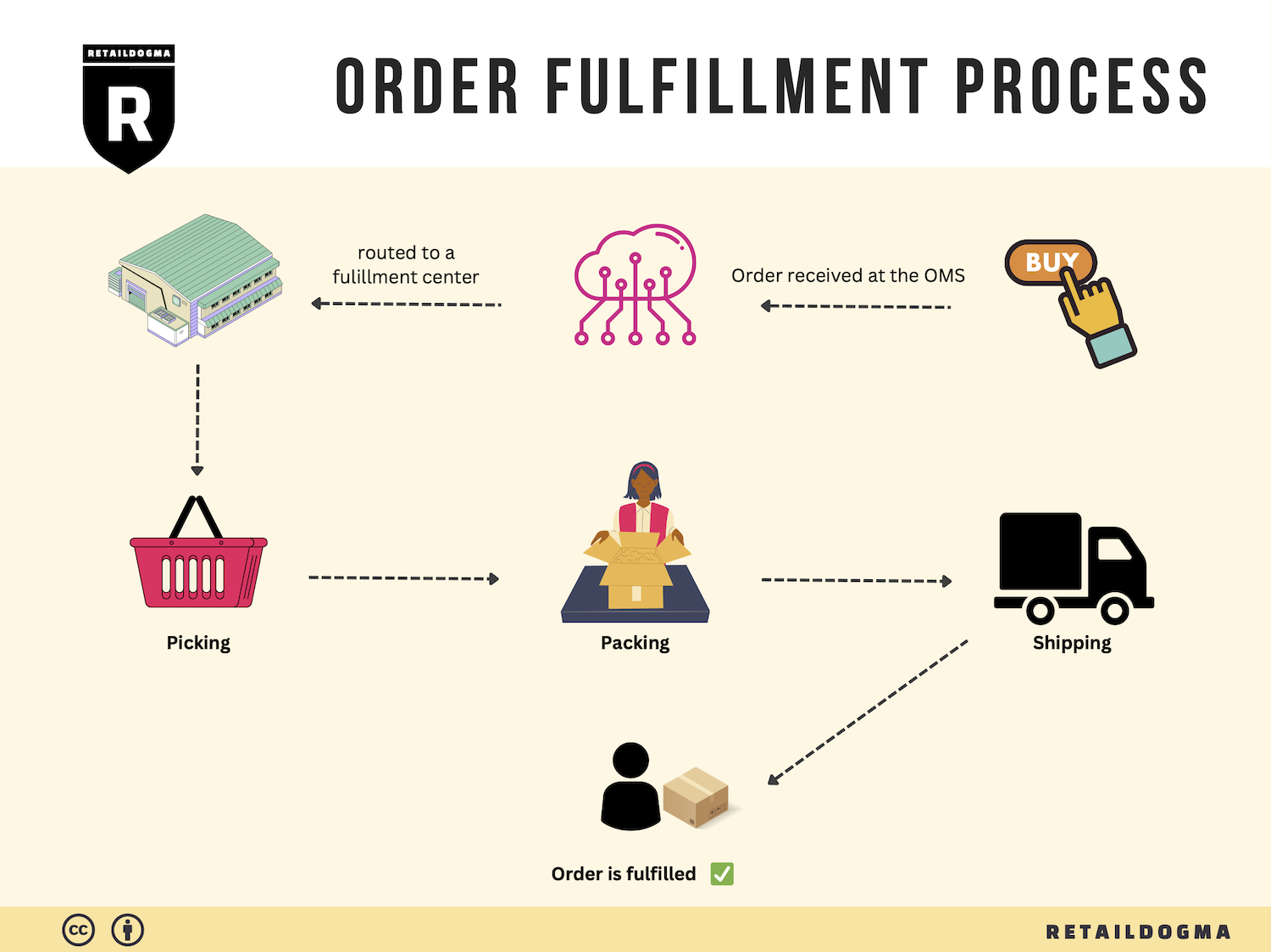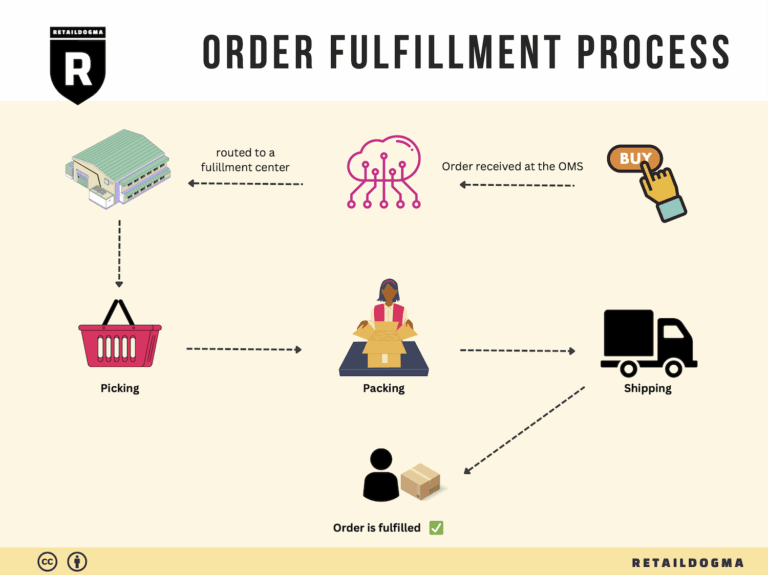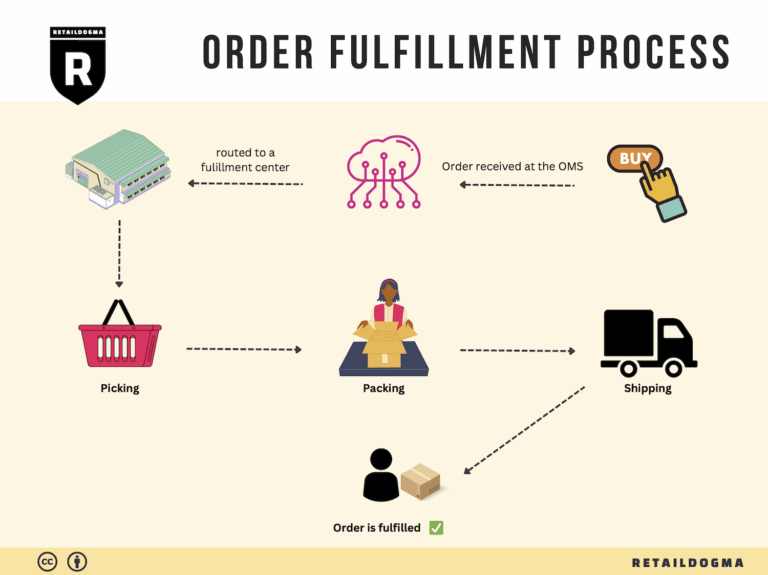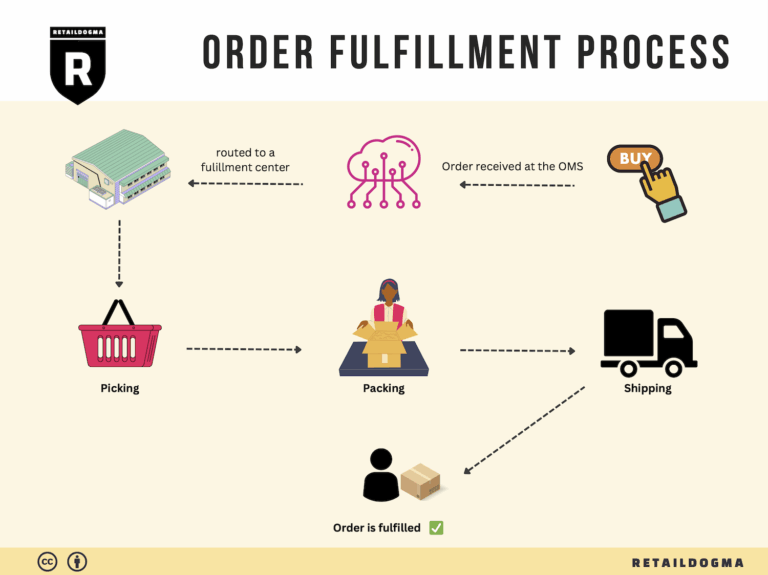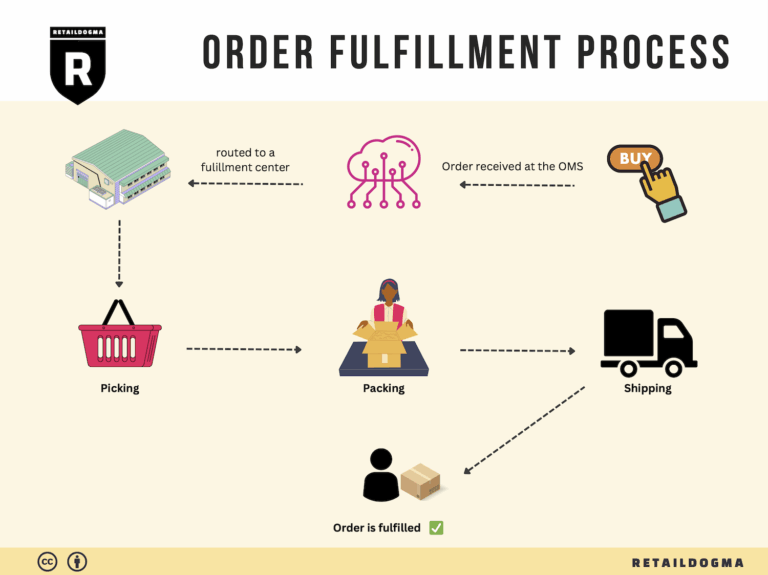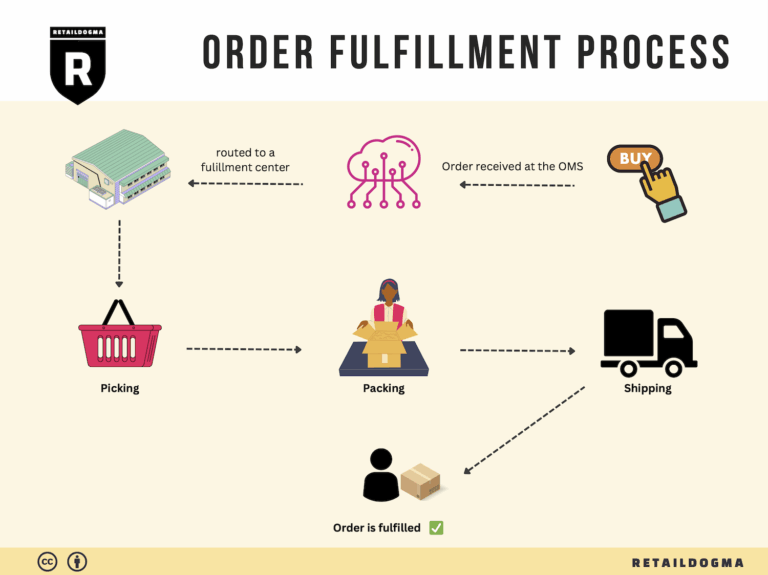How Order Fulfillment Works: A Step-by-Step Guide for Businesses
What is E-commerce Fulfillment? An Introduction for Growing Businesses
Navigating the Complexities of E-commerce Fulfillment
As e-commerce businesses grow, many entrepreneurs find themselves grappling with the daunting task of managing order fulfillment. The excitement of increasing sales can quickly become overshadowed by the complexities of packing and shipping orders efficiently. From inventory management to shipping logistics, the fulfillment process can feel overwhelming. This is where understanding e-commerce fulfillment becomes crucial.
At its core, e-commerce fulfillment is simply the process of getting a product into the hands of a customer. It encompasses everything from inventory storage and order processing to packing and shipping. For growing online businesses, mastering this process is essential for sustaining growth and enhancing customer satisfaction.
This guide aims to demystify the fulfillment landscape by exploring various fulfillment models that can support your business. We’ll cover traditional methods, such as in-house fulfillment, as well as third-party logistics (3PL) and fulfillment by Amazon (FBA). Understanding these options will help you identify which model aligns best with your business needs and customer expectations.
In addition to models, we’ll delve into the core services associated with e-commerce fulfillment. This includes inventory management, order processing, packing, shipping, and returns handling. Each of these services plays a critical role in ensuring that customers receive their orders on time and in good condition, which is vital for maintaining your brand’s reputation.
Choosing the right fulfillment partner is another key aspect that this guide will address. The right partner can significantly enhance your operational efficiency and customer experience. We’ll provide insights into what to look for in a fulfillment partner, including technology capabilities, scalability, and customer service.
Finally, we’ll touch on pricing strategies, which can often be a source of confusion for growing businesses. Understanding the costs associated with different fulfillment models will empower you to make informed financial decisions that align with your growth objectives.
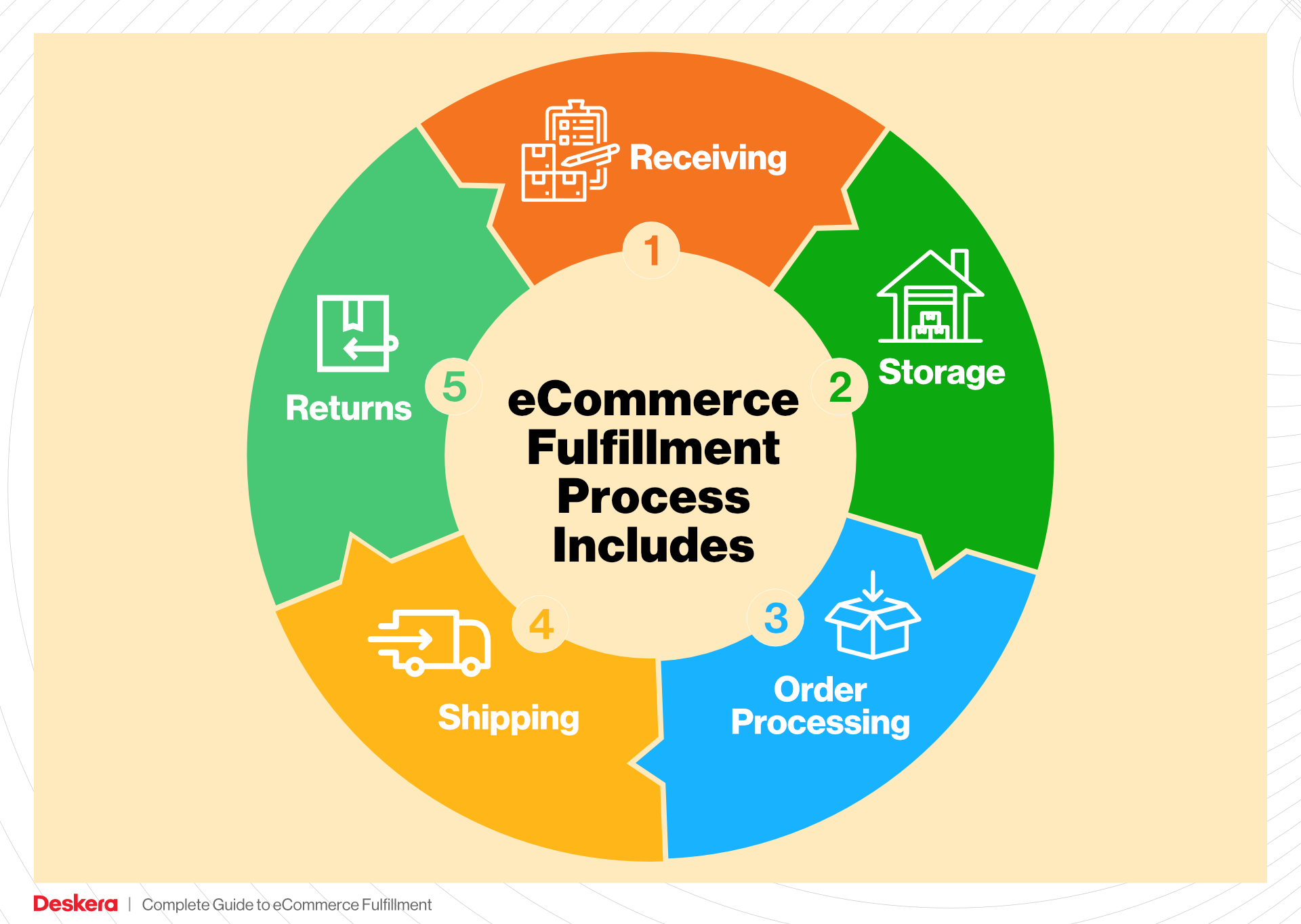
The goal of this guide is to empower e-commerce businesses to make smart, strategic decisions about their logistics. By understanding the nuances of e-commerce fulfillment, you can streamline your operations, enhance customer satisfaction, and ultimately drive sales growth. Whether you’re just starting out or looking to scale, this guide will provide the insights you need to navigate the complexities of fulfillment with confidence.
What You’ll Learn In This Guide
- What is E-commerce Fulfillment? An Introduction for Growing Businesses
- The Order Fulfillment Process: From ‘Buy’ Button to Customer’s Door
- Comparing Fulfillment Models: In-House vs. 3PL vs. Dropshipping
- A Deep Dive into Amazon FBA: Pros, Cons, and Who It’s For
- Core Services Offered by Fulfillment Centers
- How to Choose a Fulfillment Partner: A 6-Point Checklist
- Understanding Fulfillment Pricing: A Breakdown of Common Fees
- Frequently Asked Questions (FAQs) about Fulfillment
- Conclusion: Is Outsourcing Fulfillment the Right Move for Your Business?
- Important Disclaimer
The Order Fulfillment Process: From ‘Buy’ Button to Customer’s Door
1. Receiving Inventory
The order fulfillment process begins with the receipt of inventory. When products are delivered to a fulfillment center, they must be checked against purchase orders to ensure accuracy. This involves verifying quantities, inspecting for damage, and confirming that the correct items have been received.
Importance: Proper receiving is crucial for maintaining accurate inventory levels and preventing stock discrepancies that can lead to order fulfillment errors. Efficient receiving processes help minimize the time products spend in transit, allowing them to move quickly into storage or processing.
Key Term: SKU (Stock Keeping Unit) – Each product is assigned a unique SKU, which helps in tracking inventory and managing stock levels effectively.
2. Warehouse Storage
Once the inventory is received and verified, the next step is warehouse storage. Items are categorized and placed in designated storage locations, often utilizing a systematic approach to maximize space and efficiency. This can involve shelving, bins, or pallets, depending on the type and volume of products.
Importance: Effective storage solutions help ensure that products are easily accessible when needed for order fulfillment. Proper organization reduces the time spent searching for items, thereby speeding up the picking process. Additionally, a well-structured storage system aids in inventory management by making it easier to track stock levels and locations.
Key Term: ABC Analysis – This inventory categorization technique prioritizes items based on their sales volume and value, helping businesses focus on the most critical products.
3. Order Picking
Order picking is the process of retrieving items from storage to fulfill customer orders. This step involves generating pick lists, which detail the items and quantities needed for each order. Warehouse staff then navigate the storage area to gather these items.
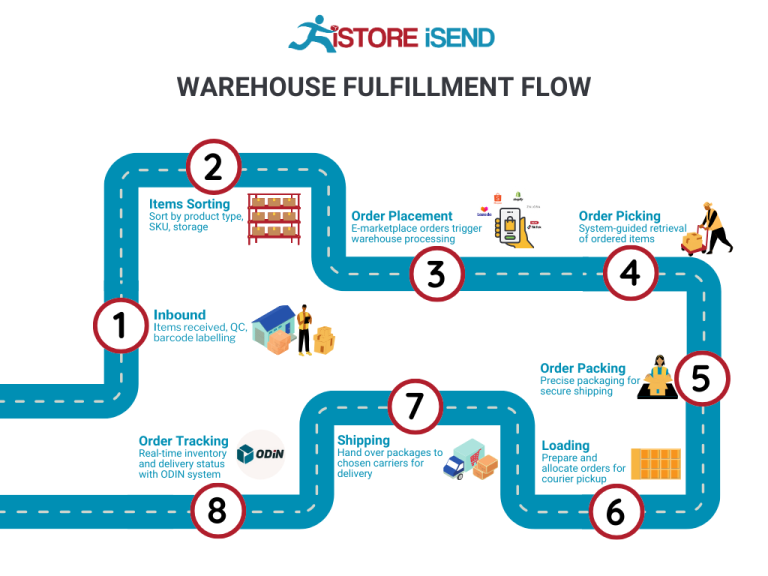
Importance: Efficient picking processes are vital for timely order fulfillment. The faster and more accurately items are picked, the quicker they can be packed and shipped. Additionally, effective picking strategies, such as batch picking (picking multiple orders simultaneously), can significantly improve productivity.
Key Term: Pick Lists – These documents outline the items to be picked for each order, serving as a guide for warehouse staff during the picking process.
4. Order Packing
After items have been picked, they are brought to the packing station. Here, products are prepared for shipment, which includes checking for accuracy against the order, packaging items securely, and labeling packages for delivery. This step may also involve including packing slips or promotional materials.
Importance: Proper packing is essential to prevent damage during transit and ensure that customers receive the correct items. Effective packing processes enhance customer satisfaction by ensuring that orders arrive safely and in good condition. Moreover, efficient packing can optimize shipping costs by reducing package size and weight.
Key Term: Packaging Materials – These include boxes, bubble wrap, and tape, which are used to protect items during shipping and ensure they reach customers in perfect condition.
5. Shipping & Delivery
The final step in the order fulfillment process is shipping and delivery. Once packages are packed, they are handed over to shipping carriers for delivery to customers. This step involves selecting the appropriate shipping method based on factors such as cost, delivery speed, and customer preference.
Importance: Timely shipping and delivery are critical for customer satisfaction and repeat business. The choice of shipping method can also affect costs and delivery times, making it essential for businesses to optimize this step to enhance their overall fulfillment strategy.
Key Term: Last-Mile Delivery – This term refers to the final leg of the shipping process, where the package is delivered from a transportation hub to the final destination, which is often the customer’s home or office. Efficient last-mile delivery can significantly impact customer experience.
By understanding and optimizing each step of the order fulfillment process, e-commerce businesses can improve their efficiency, enhance customer satisfaction, and ultimately drive growth in their operations.
Comparing Fulfillment Models: In-House vs. 3PL vs. Dropshipping
Fulfillment Model Comparison
| Model | Who Handles Inventory | Best For (Business Stage) | Key Advantage | Key Disadvantage |
|---|---|---|---|---|
| In-House Fulfillment | Business itself | Established businesses | Greater control over inventory and processes | High overhead costs and resource demands |
| Third-Party Logistics (3PL) | External logistics provider | Startups to mid-sized businesses | Scalability and reduced operational burden | Less control over inventory and fulfillment speed |
| Dropshipping | Supplier | New entrepreneurs and small businesses | Low upfront investment and operational simplicity | Lower profit margins and less brand control |
In-House Fulfillment
In-house fulfillment is a model where a business manages its own inventory and logistics operations. This approach is ideal for established companies that have the necessary resources and infrastructure to handle order fulfillment. By keeping fulfillment in-house, businesses maintain greater control over their inventory, allowing for efficient management of stock levels and order processing. Additionally, in-house fulfillment can enhance customer satisfaction due to direct oversight of shipping times, packaging, and returns processes.
However, this model comes with significant challenges. Businesses must invest in warehousing, staffing, and technology, which can lead to high overhead costs. Furthermore, as order volumes increase, so does the complexity of operations, requiring ongoing investment in systems and processes to maintain efficiency. For companies looking to scale quickly, the resource demands of in-house fulfillment can become a burden, making it less feasible compared to other models.
Third-Party Logistics (3PL)
Third-party logistics (3PL) involves outsourcing logistics and fulfillment operations to an external provider. This model is particularly advantageous for startups and mid-sized businesses that lack the infrastructure or capital to manage fulfillment in-house. By partnering with a 3PL, businesses can leverage the provider’s expertise, technology, and network of distribution centers, allowing for efficient scaling as order volumes increase.
One of the key advantages of 3PL is the ability to focus on core business activities while the logistics provider handles warehousing, packing, and shipping. This not only reduces operational burdens but also allows for faster market entry and adaptability to changing consumer demands. However, the main drawback is the loss of control over inventory and fulfillment processes. Companies may face challenges with communication and coordination, especially if the 3PL fails to meet service level agreements. Additionally, businesses should carefully vet potential 3PL partners to ensure alignment with their operational standards and customer service expectations.
Dropshipping
Dropshipping is a fulfillment model where the retailer does not hold inventory. Instead, when a customer places an order, the retailer purchases the item from a third-party supplier, who then ships it directly to the customer. This model is particularly appealing to new entrepreneurs and small businesses due to its low upfront investment. Retailers can offer a wide range of products without the financial burden of maintaining inventory.
The primary advantage of dropshipping is the operational simplicity it provides. Businesses can quickly test new products and markets without significant financial risk. However, dropshipping also comes with notable disadvantages. Profit margins are typically lower than in traditional retail models, as suppliers take a cut of the sales. Additionally, businesses have limited control over the shipping process, which can lead to delays, inconsistencies in product quality, and challenges in managing customer expectations. As a result, while dropshipping offers a low-risk entry point into e-commerce, it may not be sustainable for long-term growth without careful management of supplier relationships and customer service.
In summary, each fulfillment model—In-House, 3PL, and Dropshipping—offers distinct advantages and challenges. Businesses must carefully evaluate their operational capabilities, growth aspirations, and customer service priorities to select the model that aligns best with their strategic goals.
A Deep Dive into Amazon FBA: Pros, Cons, and Who It’s For
What is Fulfillment by Amazon (FBA)?
Fulfillment by Amazon (FBA) is a logistics service provided by Amazon that allows sellers to store their products in Amazon’s fulfillment centers. Once a customer places an order, Amazon takes care of storage, packaging, shipping, and customer service, including returns. This service is particularly appealing for e-commerce businesses looking to streamline their operations and leverage Amazon’s robust logistics network.
When a seller enrolls in FBA, they send their inventory to Amazon’s warehouses. Amazon then handles the entire order fulfillment process. This includes picking the product from the shelves, packing it, and shipping it to the customer. FBA also allows sellers to offer Prime shipping, which can significantly increase sales, given that Prime members tend to favor products that qualify for expedited shipping.
How Does FBA Work?
-
Inventory Management: Sellers send their products to Amazon’s fulfillment centers. Amazon manages the inventory, ensuring that products are available for shipment as orders come in.
-
Order Processing: When an order is placed, Amazon’s system automatically picks, packs, and ships the product from its fulfillment center. This process is designed to be quick and efficient, often resulting in same-day or next-day delivery.
-
Customer Service: Amazon handles customer inquiries and returns for FBA products. This means sellers can focus on other aspects of their business while Amazon manages customer support.
-
Multi-Channel Fulfillment: Sellers can also use FBA to fulfill orders from other sales channels, such as their own website or other online marketplaces. This flexibility makes FBA an attractive option for businesses looking to diversify their sales channels.
Pros of FBA
1. Prime Eligibility
One of the most significant advantages of using FBA is the ability to offer Prime shipping. Products fulfilled by Amazon are eligible for Prime, which means they can be shipped to customers with the speed and reliability that Prime members expect. This can lead to increased sales, as many customers filter their searches to show only Prime-eligible items.
2. Customer Trust
Products fulfilled by Amazon often carry a level of trust and credibility among consumers. Many customers prefer to buy from sellers who use FBA, as they associate it with quality service, fast shipping, and reliable returns. This trust can translate into higher conversion rates for FBA sellers.
3. Multi-Channel Fulfillment
FBA allows sellers to fulfill orders from multiple sales channels. Whether selling on Amazon, eBay, or their own website, sellers can streamline their logistics by using FBA to handle all order fulfillment. This capability simplifies inventory management and logistics while providing consistency in shipping and customer service.
4. Scalability
FBA enables sellers to scale their operations without the need to invest in warehousing and logistics infrastructure. As demand for products grows, sellers can simply send more inventory to Amazon, allowing for rapid growth without the logistical headaches.
5. Time Savings
By outsourcing fulfillment to Amazon, sellers can save significant time and resources. This allows them to focus on product development, marketing, and other essential business activities rather than managing logistics.
Cons of FBA
1. High Fees
One of the most significant drawbacks of FBA is the cost. Amazon charges various fees, including storage fees for holding inventory in their warehouses and fulfillment fees for picking, packing, and shipping products. These costs can add up, especially for low-margin products, potentially eating into profits.
2. Strict Inventory Rules
Sellers must adhere to Amazon’s strict inventory management policies. This includes guidelines on labeling, packaging, and even how much inventory can be stored. Failure to comply with these rules can result in penalties or additional fees.
3. Commingling Risks
FBA operates on a commingling model, which means that inventory from different sellers may be stored together. This can lead to issues if a seller’s product is returned or lost, as it may be difficult to track down the original item. In some cases, sellers may receive returns for products that were not theirs, complicating inventory management.
4. Limited Control
While FBA offers many conveniences, it also means that sellers have less control over the fulfillment process. This can be a concern for brands that want to maintain a specific level of customer service or branding during the shipping process.
5. Inventory Limitations
During peak seasons, Amazon may impose inventory limits on sellers, which can restrict their ability to fulfill demand. This can be particularly challenging for businesses that experience seasonal spikes in sales.
Who is FBA Best For?
Fulfillment by Amazon is particularly well-suited for:
-
Small to Medium-Sized Businesses: Companies that do not have the resources to manage their own fulfillment logistics can benefit significantly from FBA. It allows them to compete with larger retailers without investing heavily in infrastructure.
-
E-commerce Entrepreneurs: New sellers looking to enter the e-commerce space can leverage FBA to get their products in front of a vast audience quickly, taking advantage of Amazon’s established customer base.
-
Brands with High Sales Volume: Sellers who anticipate a high volume of orders can benefit from FBA’s efficient logistics. The scalability of FBA allows businesses to grow without worrying about storage or shipping logistics.
-
Multi-Channel Sellers: Businesses selling across multiple platforms can streamline their operations by using FBA for all order fulfillment, making it easier to manage inventory and logistics.
In conclusion, while Fulfillment by Amazon offers numerous advantages, including increased sales potential and time savings, it also comes with challenges such as high fees and strict inventory policies. Sellers should carefully evaluate their business needs, profit margins, and growth strategies to determine if FBA is the right fit for their operations.
Core Services Offered by Fulfillment Centers
Inventory Management & Warehousing
Inventory management is a critical component of e-commerce operations that involves tracking and controlling stock levels, orders, sales, and deliveries. Fulfillment centers excel in this area by utilizing sophisticated inventory management systems that integrate real-time data and analytics. These systems enable businesses to maintain optimal stock levels, reduce excess inventory, and ensure that products are available for customers when needed.
One of the primary benefits of effective inventory management is the reduction of carrying costs. By having a clear view of inventory levels, e-commerce businesses can avoid overstocking and understocking issues, both of which can be costly. Additionally, fulfillment centers often employ advanced technologies such as RFID tags and barcode scanning, which enhance accuracy and efficiency in inventory tracking. This leads to improved order fulfillment rates, customer satisfaction, and ultimately, better sales performance.
Warehousing in fulfillment centers typically involves strategically located facilities that are close to major consumer markets. This proximity allows for faster shipping times and lower transportation costs. By leveraging these warehouses, e-commerce businesses can streamline their logistics and improve their overall supply chain efficiency.
Pick and Pack Services
Pick and pack services are essential for e-commerce operations, as they involve selecting items from inventory (picking) and preparing them for shipment (packing). Fulfillment centers specialize in these services, utilizing organized storage systems and trained staff to ensure that orders are processed quickly and accurately.
The primary advantage of pick and pack services is the speed at which orders can be fulfilled. Fulfillment centers often employ automated systems and optimized workflows that reduce the time it takes to pick items and pack them for shipping. This efficiency not only improves customer satisfaction due to faster delivery times but also allows businesses to scale their operations without the need for a proportional increase in labor costs.
Moreover, fulfillment centers can handle a wide variety of order sizes and complexities. Whether it’s a single-item order or a bulk order with multiple SKUs, these centers can adapt their processes to meet the specific needs of the business. This flexibility is crucial for e-commerce companies that experience fluctuating demand, allowing them to respond quickly to market changes.
Kitting and Assembly
Kitting and assembly refer to the process of combining multiple products into a single package or kit for sale. This service is particularly valuable for e-commerce businesses that sell products that are often purchased together or require assembly before use, such as DIY furniture or gift sets.
The benefit of kitting and assembly services lies in their ability to create a more streamlined purchasing experience for customers. By offering bundled products, businesses can increase average order values and enhance customer satisfaction. Additionally, fulfillment centers can manage the complexities of assembly, ensuring that products are correctly packaged and ready for shipment, which reduces the burden on the business itself.
Kitting also allows for better inventory management. By packaging items together, businesses can reduce the number of individual SKUs they need to track, simplifying their inventory processes. Furthermore, fulfillment centers can provide insights into which kits are performing well, enabling businesses to make informed decisions about product offerings and marketing strategies.
Returns Management (Reverse Logistics)
Returns management, or reverse logistics, is the process of handling product returns from customers. This service is increasingly important in the e-commerce sector, where return rates can be significantly higher than in traditional retail. Fulfillment centers offer comprehensive returns management solutions that streamline the return process for both the business and the customer.
The key benefit of efficient returns management is the ability to quickly process returns and restock items. Fulfillment centers typically have established procedures for inspecting returned items, determining their condition, and either restocking them for resale or managing them through alternative channels. This efficiency minimizes the financial impact of returns and helps maintain accurate inventory levels.
Additionally, effective returns management enhances customer experience. A simple, hassle-free return process can improve customer loyalty and satisfaction, encouraging repeat purchases. Fulfillment centers can also provide valuable data on return trends, helping e-commerce businesses identify issues with specific products and make necessary adjustments to improve quality and reduce future returns.
In summary, the core services offered by fulfillment centers—inventory management and warehousing, pick and pack services, kitting and assembly, and returns management—are essential for e-commerce businesses looking to scale their operations efficiently. By leveraging these services, businesses can improve their logistics, enhance customer satisfaction, and ultimately drive sales growth.
How to Choose a Fulfillment Partner: A 6-Point Checklist
Location & Warehouse Network
Why It’s Important:
The geographic location of your fulfillment partner’s warehouses can significantly impact shipping times and costs. A partner with multiple strategically located warehouses can help you reach your customers faster and more efficiently, reducing shipping expenses and improving customer satisfaction.
Questions to Ask:
– Where are your warehouses located, and how does this align with our target customer demographics?
– Do you have a network of warehouses that can handle our specific shipping needs (e.g., regional, national, international)?
– How do you manage inventory across different locations to ensure stock availability?
Technology & Integrations
Why It’s Important:
In today’s digital landscape, robust technology is crucial for streamlining operations and ensuring seamless communication between your e-commerce platform and the fulfillment partner. A partner with advanced technology can offer better inventory management, real-time tracking, and automated order processing.
Questions to Ask:
– What technology platforms do you use for inventory management and order processing?
– Can your systems integrate with our e-commerce platform (e.g., Shopify, Magento, WooCommerce)?
– Do you provide real-time tracking and reporting capabilities for orders and inventory?
– How do you ensure data security and compliance with regulations?
Specializations (e.g., Cold Storage, Oversized Items)
Why It’s Important:
Not all fulfillment partners can handle specialized products. If your business involves perishable goods, oversized items, or hazardous materials, it’s crucial to partner with a fulfillment center that has the necessary facilities and expertise.
Questions to Ask:
– Do you have specialized facilities for our product types (e.g., cold storage, climate control, or oversized item handling)?
– What certifications do you hold for handling specialized products?
– How do you manage quality control for specialized items during storage and shipping?
Scalability & Capacity
Why It’s Important:
As your business grows, your fulfillment needs will evolve. A capable fulfillment partner should be able to scale operations quickly to accommodate increased order volumes without sacrificing service quality.
Questions to Ask:
– How do you handle spikes in order volume (e.g., during holidays or promotional events)?
– What is your current capacity, and how quickly can you scale up operations if needed?
– Can you provide references from clients who have scaled their operations with your support?
Pricing and Contracts
Why It’s Important:
Understanding the pricing structure and contract terms is essential to avoid unexpected costs and ensure a mutually beneficial relationship. Transparent pricing will help you budget effectively and maintain profitability.
Questions to Ask:
– What is included in your pricing model (e.g., storage fees, pick and pack fees, shipping costs)?
– Are there any hidden fees we should be aware of?
– What are the terms of the contract, and how flexible are they if our needs change?
– Do you offer volume discounts or incentives for long-term contracts?
Customer Support & Reviews
Why It’s Important:
Reliable customer support can make or break your fulfillment experience. A partner that provides excellent customer service can help resolve issues quickly, ensuring your operations run smoothly. Additionally, reviews and testimonials from other clients can provide insight into the partner’s reliability and performance.
Questions to Ask:
– What level of customer support do you offer (e.g., dedicated account manager, 24/7 support)?
– How do you handle inquiries and issue resolution?
– Can you provide case studies or references from clients similar to our business?
– What do your reviews say about your responsiveness and service quality?
Conclusion
Choosing the right fulfillment partner is a critical decision that can significantly impact your business’s efficiency and customer satisfaction. By following this checklist, you can ensure that you select a partner that aligns with your operational needs and growth objectives. Take the time to ask the right questions and thoroughly evaluate potential partners to set your business up for success in the competitive e-commerce landscape.
Understanding Fulfillment Pricing: A Breakdown of Common Fees
Initial Setup Fees
Initial setup fees are one-time charges that cover the costs associated with onboarding your business into a fulfillment center’s system. These fees can include account setup, software integration, and sometimes even training for your staff on how to use the fulfillment center’s systems. The calculation of initial setup fees can vary significantly depending on the complexity of your operations and the fulfillment provider’s requirements.
For example, if you are integrating a sophisticated inventory management system or require custom packaging solutions, expect higher initial costs. It’s crucial to discuss your specific needs with the fulfillment provider to get a clear picture of what these fees will entail.
Receiving Fees
Receiving fees are charged for the process of accepting and inspecting incoming inventory. This includes unloading products from delivery vehicles, checking them against purchase orders, and storing them in the warehouse. Typically, receiving fees are calculated per pallet or per item, depending on the fulfillment center’s pricing structure.
For instance, if a fulfillment center charges $20 per pallet received, and you send 10 pallets, your total receiving fee would be $200. Some providers may also charge additional fees for items that require special handling, such as fragile goods or temperature-sensitive products. Understanding these fees upfront can help you budget effectively and avoid surprises.
Storage Fees (per pallet/bin)
Storage fees are ongoing charges for keeping your inventory in the fulfillment center’s warehouse. These fees can be calculated on a per-pallet or per-bin basis, and they can vary based on the size of the items stored, the duration of storage, and the specific location within the warehouse.
For example, a fulfillment center may charge $15 per pallet per month. If you store 5 pallets for 3 months, your storage fees would amount to $225. It’s important to note that some providers might have tiered pricing based on volume, meaning larger quantities could result in lower per-pallet rates. Always clarify how storage fees are structured to understand your potential costs.
Pick & Pack Fees (per item/order)
Pick and pack fees are charged for the labor involved in retrieving items from storage and preparing them for shipment. These fees can be assessed per item or per order, depending on the fulfillment center’s pricing model.
For instance, if a fulfillment center charges $1 per item and you have an order consisting of 5 items, the pick and pack fee would be $5. If the fee is assessed per order, you would pay a flat rate for any number of items in that order. This fee can also vary based on the complexity of the packing process, such as the need for special packaging or custom labeling. When evaluating fulfillment options, inquire about how pick and pack fees are structured and if there are any additional costs for special requests.
Shipping Fees
Shipping fees cover the cost of delivering orders to customers and can vary widely based on factors such as package weight, dimensions, destination, and the shipping method selected (e.g., standard, expedited). Fulfillment centers often have negotiated rates with carriers, which can lead to cost savings for your business.
Shipping fees are typically calculated based on the dimensional weight of the package, which takes into account both the weight and size of the item. For example, if you ship a package that weighs 10 pounds but has a large volume, the shipping cost might be based on its dimensional weight rather than its actual weight. Understanding how shipping fees are calculated will help you choose the most cost-effective shipping options for your business.
Tips for Getting an Accurate Quote
-
Be Specific About Your Needs: Clearly outline your business model, product types, and order volume. The more information you provide, the more accurate the quote will be.
-
Request a Detailed Breakdown: Ask for a detailed breakdown of all potential fees, including any additional charges that may apply to your specific products.
-
Compare Multiple Providers: Don’t settle for the first quote you receive. Compare multiple fulfillment centers to find the best fit for your needs.
-
Ask About Discounts: Inquire about volume discounts or promotional offers that could lower your overall costs.
-
Review the Contract Carefully: Before signing, ensure you understand all terms and conditions, especially regarding fee structures and any potential penalties for changes in order volume or inventory levels.
By following these tips, you can ensure you receive an accurate and comprehensive quote that aligns with your e-commerce business’s operational needs.
Frequently Asked Questions (FAQs) about Fulfillment
FAQs about Macy’s Fulfillment Center
-
What is Macy’s fulfillment center?
Macy’s fulfillment center refers to a network of decentralized facilities located primarily in the back of retail stores. These centers are designed to streamline the order fulfillment process for e-commerce by bringing inventory closer to customers, enabling quicker shipping and enhanced service. -
How does Macy’s fulfillment center differ from a traditional warehouse?
A traditional warehouse is typically a large, standalone facility focused solely on storage and distribution. In contrast, Macy’s fulfillment centers are integrated within retail stores, allowing for efficient in-store order processing, pickup options, and reduced shipping times by leveraging existing real estate. -
What advantages does Macy’s fulfillment center offer for e-commerce operations?
The primary advantages include faster delivery times due to proximity to customers, reduced operational costs by utilizing existing store infrastructure, and the ability to fulfill orders from both online and in-store inventories seamlessly. -
What is a Third-Party Logistics Provider (3PL)?
A 3PL is a service provider that manages logistics and supply chain operations for businesses. This includes warehousing, transportation, inventory management, and fulfillment services. Utilizing a 3PL can help businesses scale efficiently without the need to invest heavily in infrastructure. -
How much do fulfillment services cost?
Costs for fulfillment services vary widely based on factors such as order volume, storage needs, and specific service offerings. Typically, businesses can expect to pay for storage space, picking and packing services, shipping fees, and any additional handling. It’s essential to evaluate multiple providers to find a solution that aligns with your budget and operational needs. -
Can businesses use Macy’s fulfillment center for their own products?
No, Macy’s fulfillment centers are specifically designed for Macy’s own inventory and e-commerce operations. Businesses looking for fulfillment services should consider partnering with dedicated 3PL providers that can accommodate their specific product lines and requirements. -
How does Macy’s handle inventory management in its fulfillment centers?
Macy’s employs advanced inventory management systems that integrate online and in-store stock levels. This allows for real-time tracking, efficient order processing, and the ability to fulfill online orders directly from store inventory, minimizing stockouts and excess inventory. -
What role does technology play in Macy’s fulfillment operations?
Technology is integral to Macy’s fulfillment operations, with automated systems for inventory management, order processing, and shipping logistics. Enhancements, such as upgraded freight elevators and packing stations, improve operational efficiency and speed up the fulfillment process. -
How does Macy’s ensure the safety of products during the fulfillment process?
Macy’s utilizes safety protocols and modern equipment, including upgraded freight elevators and packing stations, to ensure products are handled securely. These measures include compliance with safety regulations, employee training, and the use of durable materials designed for high-volume operations. -
What is the impact of Macy’s fulfillment center on customer satisfaction?
By decentralizing fulfillment and bringing inventory closer to customers, Macy’s can offer faster shipping, more accurate order fulfillment, and convenient in-store pickup options. This enhances the overall customer experience, leading to higher satisfaction and loyalty among shoppers.
Conclusion: Is Outsourcing Fulfillment the Right Move for Your Business?
Evaluating the Benefits of Outsourcing Fulfillment
Outsourcing your fulfillment can be a transformative strategy for e-commerce businesses looking to scale efficiently. One of the primary benefits is the significant time savings it offers. By partnering with a dedicated fulfillment service, you can focus on core business activities like marketing and product development, rather than getting bogged down in logistics and shipping processes. This shift not only enhances productivity but also allows you to respond more effectively to market trends and customer demands.
Scalability is another crucial advantage. As your business grows, so does the complexity of managing inventory, shipping, and returns. A fulfillment partner can provide the infrastructure and resources needed to scale operations seamlessly. Whether you experience seasonal spikes in demand or are looking to expand into new markets, outsourcing allows you to adapt without the need for heavy capital investment in warehouses or technology.
Moreover, fulfillment services bring expertise to the table. They are equipped with the latest technology and industry best practices, ensuring that your orders are processed efficiently and accurately. This can lead to improved customer satisfaction through faster delivery times and fewer errors, which are vital for maintaining a competitive edge in today’s e-commerce landscape.
However, it is essential to choose the right fulfillment partner. Conduct thorough research and due diligence to ensure that their capabilities align with your business needs and growth plans. Look for partners who have a proven track record in your industry, and who can provide the flexibility and support necessary to facilitate your growth.
Call to Action
Take a moment to audit your current shipping and fulfillment processes. Are they hindering your growth? If so, consider whether a fulfillment partner could be the strategic next step for your business. Evaluate your options, and don’t hesitate to reach out for expert advice tailored to your specific needs. Your journey to optimized fulfillment starts now.
Important Disclaimer
⚠️ Important Disclaimer
The information in this guide is for educational purposes. Fulfillment services, pricing, and platform features change frequently. Always conduct your own due diligence and consult with providers directly before making business decisions.
